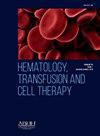PREDICTORS OF RESPONSE TO RUXOLITINIB THERAPY IN PATIENTS WITH MYELOFIBROSIS
IF 1.6
Q3 HEMATOLOGY
引用次数: 0
Abstract
Presentation Type
Oral.
Abstract Category
Adult Hematology Abstract Categories -> Myeloproliferative Neoplasms.
Objective
Since the introduction of targeted therapy for myelofibrosis and the incorporation of ruxolitinib into clinical practice, overall survival rates have significantly improved. Despite initial effectiveness, most patients eventually lose their response, and after stopping treatment, they have poor Overall Survival rates (OS). Currently, response criteria that can predict a response or indicate treatment failure are not well studied in patients receiving ruxolitinib.
Aim
To analyze therapy with ruxolitinib and identify early predictors of response or treatment failure
Methodology
The study included 225 patients (79 men and 145 women). The median age at the start of ruxolitinib therapy was 60 years (range 27–84).
• 149 patients (65%) were diagnosed with primary myelofibrosis;
• 55 patients (25%) had post-polycythemia vera myelofibrosis;
• 16 patients (7%) had post-thrombocythemia myelofibrosis;
• 8 patients (3%) were diagnosed with essential thrombocythemia.
For 169 patients (75%), the time to ruxolitinib therapy initiation was more than two years. According to the DIPSS prognostic scale, 88 patients (39%) were in the intermediate-1 risk group, 110 patients (49%) were in the intermediate-2 risk group, and 26 patients (12%) were in the high-risk group. Most patients (82%) had the JAK2V617F mutation, 13% had a mutation in the CALR gene, 2% had a mutation in the MPL gene, and 4 patients were triple negative. 121 patients (54%) had a normal karyotype, and 51 patients (23%) had an unfavorable karyotype. An enlarged spleen size of more than 10 cm upon palpation was observed in 108 patients.
Results
The median duration of ruxolitinib therapy was 22 months (range 7–123). In 91% of cases, the therapeutic dose of the drug was 30 mg per day or more, and in 9% it was less due to the presence of thrombocytopenia.
• Disease stabilization was recorded in 7 patients (35%);
• Clinical improvement was observed in 86 patients (38%);
• Disease progression was noted in 60 patients (27%).
In 75% of cases, a reduction in spleen size compared to baseline was achieved, and in 80 patients (40%), some reduction in disease symptoms was observed. In 70% of cases, there was no need for blood transfusion therapy. Ruxolitinib therapy led to an increase in the proportion of patients with low and intermediate-1 risk (53% vs. 39%). At the time of the current analysis, 184 patients (82%) were alive, and 40 patients (18%) had died. Overall survival rates were 72% in the intermediate-1 risk group, 60% in the intermediate-2 group, and 48% in the high-risk group (p < 0.0001). To build a predictive model of the response to therapy, a new RR6 calculator was used. The low-risk group included 46 patients (overall survival ‒ 86%), the intermediate-risk group ‒ 60 patients (overall survival ‒ 83%), and the high-risk group ‒ 59 patients (overall survival ‒ 55%) (p < 0.0015).
Conclusion
Ruxolitinib is the standard of care for patients with myelofibrosis. The RR6 prognostic model can be applied to patients with myelofibrosis after 6 months of ruxolitinib treatment to identify risk groups with an unfavourable course and those requiring a change in treatment strategy.
骨髓纤维化患者对鲁索利替尼治疗反应的预测因素
表示TypeOral。成人血液学骨髓增殖性肿瘤。目的自骨髓纤维化的靶向治疗和鲁索利替尼纳入临床实践以来,总生存率显著提高。尽管最初有效,但大多数患者最终会失去反应,并且在停止治疗后,他们的总生存率(OS)很低。目前,在接受ruxolitinib的患者中,可以预测反应或表明治疗失败的反应标准尚未得到很好的研究。目的分析ruxolitinib治疗并确定治疗反应或治疗失败的早期预测因素。方法纳入225例患者(男性79例,女性145例)。鲁索利替尼治疗开始时的中位年龄为60岁(范围27-84岁)。149例(65%)被诊断为原发性骨髓纤维化;55例(25%)真性红细胞增多症后骨髓纤维化;16例(7%)患者有血小板增多症后骨髓纤维化;•8例患者(3%)被诊断为原发性血小板增多症。169例患者(75%)开始使用鲁索利替尼治疗的时间超过2年。根据DIPSS预后量表,88例患者(39%)为中1危组,110例患者(49%)为中2危组,26例患者(12%)为高危组。大多数患者(82%)有JAK2V617F突变,13%有CALR基因突变,2%有MPL基因突变,4例为三阴性。正常核型121例(54%),不良核型51例(23%)。108例患者触诊脾脏肿大超过10cm。结果鲁索利替尼治疗的中位持续时间为22个月(范围7-123个月)。在91%的病例中,药物的治疗剂量为每天30毫克或更多,9%的病例由于存在血小板减少症,治疗剂量更少。7例患者(35%)病情稳定;•86例患者(38%)临床改善;•60例患者(27%)出现疾病进展。在75%的病例中,脾脏大小与基线相比缩小了,在80例患者(40%)中,观察到疾病症状有所减轻。在70%的病例中,不需要输血治疗。鲁索利替尼治疗导致低危和中危患者比例增加(53%对39%)。在目前的分析中,184名患者(82%)存活,40名患者(18%)死亡。中1危组总生存率为72%,中2危组为60%,高危组为48% (p <;0.0001)。为了建立对治疗反应的预测模型,我们使用了一种新的RR6计算器。低危组46例(总生存率为86%),中危组60例(总生存率为83%),高危组59例(总生存率为55%)(p <;0.0015)。结论鲁索利替尼是骨髓纤维化患者的标准治疗方案。RR6预后模型可应用于鲁索利替尼治疗6个月后的骨髓纤维化患者,以确定病程不利的风险组和需要改变治疗策略的风险组。
本文章由计算机程序翻译,如有差异,请以英文原文为准。
求助全文
约1分钟内获得全文
求助全文
来源期刊

Hematology, Transfusion and Cell Therapy
Multiple-
CiteScore
2.40
自引率
4.80%
发文量
1419
审稿时长
30 weeks
 求助内容:
求助内容: 应助结果提醒方式:
应助结果提醒方式:


